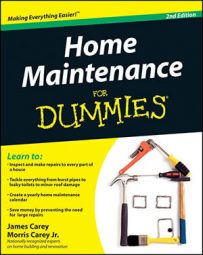Foundations are rigid and tend to crack over time. Minor cracks, though unsightly, are not normally cause for alarm. Major cracks, on the other hand, indicate substantial movement and can undermine the home’s structural integrity. Therefore, you can’t just ignore cracks in a foundation or concrete slab. Filling in these cracks and stopping them from spreading is essential to preventing serious structural issues in your home.
If your foundation or structural slab has an excessive number of smaller cracks or cracks that are larger than 1/4 inch wide, have it examined by a structural or civil engineer to assess the extent of the damage and to determine the source. If the damage is severe, consult a geotechnical or soils engineer, who can suggest solutions to correct the problem once and for all.
Even in the best of conditions, concrete moves a fraction of an inch here or there, not always resulting in a crack. And, believe it or not, concrete expands on hot days and shrinks when the weather is cold! Therefore, when patching cracks in concrete, use a product that gives a little. The more elastic the product, the less likely a crack will reappear. A vinyl concrete patch, which usually comes packaged dry in a box, is a good choice for fixing cracks over 1/8 inch thick.
To repair a small crack, follow these steps:
Clean the area and get rid of any loose chips.
For cracks wider than 1/8 inch, use a small sledgehammer and a cold chisel to chip away loose material.
Mix the concrete patch to the consistency of a thin paste.
Mix the dry patch powder with latex instead of water to give the product some added elasticity and adhesion. Also, mix only a small amount of paste at a time because most products tend to dry pretty quickly.
Mist the crack with water and then trowel the patching paste into the crack.
Wetting the crack with water before installing a patching product prevents the moisture in the patch material from being drawn out by dry concrete, which causes the patch material to crack and not form a solid bond.
Use a trowel to scrape away any excess paste and create a smooth and uniform finish.
If the existing concrete surrounding the patch is rough, you can match the finish by sweeping it with a broom.
Clean up your tools and buckets immediately to avoid the patching compound drying in and on them.
If you can’t find vinyl concrete patch material, mix one part Portland cement to three parts sand; then add enough concrete bonding agent to make a stiff mixture about the consistency of mashed potatoes. Take a small part of the mixture and add more bonding agent so that it becomes a soupy consistency. Brush the soupy mixture into the crack using an old paintbrush, and then pack the stiff mixture into the crack with a metal trowel. Use the trowel to create a smooth finish.
To repair large gaps (1/4 inch or greater) in concrete that are not structural and don’t require advice from an engineer, use a latex caulk that contains silicone or a polyurethane caulk. You pump these products into the joint with a caulking gun; the caulking products remain pliable to allow for ongoing expansion and contraction. (Because most of these caulking products are self-leveling, no troweling is required.) Be sure to lightly spray the patch with water twice a day for a week to help it cure and prevent cracking.

